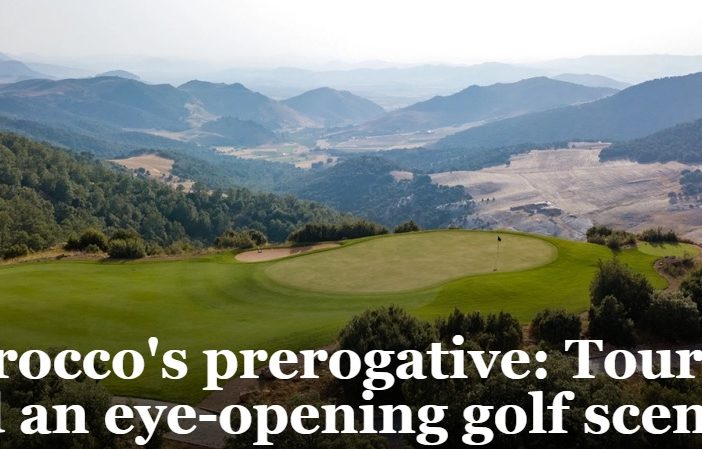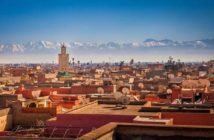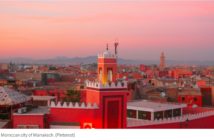Golf Week
When it comes to beehives of competitive golf, for one week each spring not many places can match Royal Golf Dar Es Salam. The 45-hole facility in the capital Rabat hosts full-field events on both the European Tour and the Ladies’ European Tour — not to mention a kids’ tournament — all at once.
In Morocco, many visitors are initially surprised the game even exists in the country and are then shocked by the depth and quality of courses on offer. This is by design, though.
Under the auspices of King Mohammed VI and his younger brother, Prince Moulay Rachid — an avid golfer who serves as the host of the Trophée Hassan II (THII) — golf is at the center of a national initiative to make tourism a major part of Morocco’s 21st-century economy. Each year they invite celebrities, former pro athletes and members of the media (including this correspondent) to play in the pro-am and cover the event.

Royal Golf Dar Es Salam during the European Tour’s Trophée Hassan II (Ross Kinnaird/Getty Images)
It’s a sound strategy, considering that much of the country has a climate similar to that of southern California, as well as an ancient tradition of hospitality befitting the country’s geographical position at the crossroads of Europe, Africa and the Arab world.
In the last decade, Morocco’s grande damehotels have been complemented by investment from major overseas brands such as Hyatt and the Four Seasons. Oceanfront courses by Kyle Phillips (Tazegzout) and Gary Player (Mazagan) have been unveiled, while the country’s preeminent tournament facility, Dar es Salam’s Red Course, completed an ambitious renovation. With the work by James Duncan, a longtime Coore & Crenshaw associate, beginning to settle into the ground, course conditions were off the charts this spring.
Designed by Robert Trent Jones Sr. in 1970, the Red still has plenty of its original flavor, though the bunkers and greens now pop like those of a new course. Duncan had the courage to court controversy in departing from the Jones script, as well. In converting the 17th from a long par-3 to a 286-yard downhill and drivable par-4, he created a bit of a bottleneck — the pros groused about the backup on the tee — but also a fascinating psychological experiment. Players who laid up would often be rewarded with short birdie looks, while those who succumbed to the temptation of such an easily drivable green (but one that tilts from front to back) could find themselves in the water long.
The THII has a colorful history that dates to the 1970s, when it became an exhibition that minted top-class champions, from Billy Casper to Lee Trevino to Payne Stewart, almost as an after-thought to its fabulous party scene. It’s more buttoned-up now, having joined the European Tour schedule in 2010. With the strength of field improving each year, it’s not hard to imagine a Rolex series slot, or some similar designation of Dar es Salam’s status as the host of “Africa’s Major” in its future.

Michlifen Golf Club (Courtesy of Michlifen Golf Club)
Into the Atlas Mountains
Perched on a high plateau overlooking the Atlantic coast, Rabat is an impressive city, with broad, leafy avenues and monumental architecture both old (the 12th-century fortress known as the Kasbah des Oudayas) and new (star architect Zaha Hadid’s Grand Theatre, which is slated to open next year). But part of the fun of visiting Morocco is getting out and exploring the country by road or rail. This is getting easier, too, as significant French investment has seen bullet trains beginning to link major cities.
This spring, though, we hired a driver for a side trip to the small city of Ifrane, in the Atlas Mountains about 2.5 hours from the capital. To say that Ifrane shows a different side of Morocco is an understatement. In the 1920s, during the period of the French protectorate, it was developed as a “hill station” to give colonial bureaucrats a summer retreat from the heat of cities like Marrakech and Casablanca.
At 5,400 feet above sea level, the air is crisp and fresh, and the town itself resembles something out of Switzerland — quiet streets, spotless parks and tidy A-frame houses with rooflines of bright orange shingles. There’s a national park, where charming (and endangered) Barbary macaques engage in their monkey business, and even a ski station nearby.
In keeping with the Alpine vibe, Ifrane’s main draw is the Michlifen Hotel, a grand, five-star lodge whose blond wood and stone construction would not be out of place in Park City, Utah. Our destination, the Michlifen Golf Club, is a few miles down the hill from its parent hotel and built to the same high standard.
Michlifen, a Jack Nicklaus signature design, was officially inaugurated last October by Prince Moulay Rachid. In some ways it feels like the kind of course American ski resorts develop in order to offer a low-season amenity. The cliff-edge clubhouse is spectacular — from the patio, the peaks of the Atlas range extend like ocean waves as far as the eye can see. It’s a million-dollar view and the clubhouse provides one of the more memorable lunch or cocktail spots in golf.
The decision to situate the clubhouse in its current location, though, likely compromised the golf. Imagine if Mike Keiser had placed his lodge, and all its attendant parking and infrastructure, where the 4th at Pacific Dunes now sits. Though Michlifen features three beautiful cliffside holes — the par-3s at 9 and 17 and the par-4 18th— the clubhouse location prevents the routing from utilizing the most dramatic property in a multi-faceted way.

Michlifen Golf Club (Courtesy of Michlifen Golf Club)
The rest of the course is a mixed bag. Much of the front nine is draped across a wide open, rocky, almost lunar landscape. In this environment, straightforward hole strategies and generic bunker shaping make for a somewhat vanilla game, though the par-5 8th, with its fairway divided by a copse of trees, is a standout. Though the front side has its forgettable moments, it is to Nicklaus’ credit that the routing is easily walkable from start to finish, which is a pleasant surprise given the mountainous setting.
Michlifen’s character changes when it crosses the entry drive at the 13th hole. This begins a four-hole run through a cedar and evergreen forest, and it does wonders for the golf. The long par-3 14th features a tranquil green site, while the double-dogleg, lake-crossing par-5 15th is a gambler’s delight. The backcountry stretch evokes one of Nicklaus’ best layouts — Mayacama, in the hills of Sonoma County, California. The golfer then emerges from the trees to play the final two cliffside holes. These are shots to be savored, especially when the sun is setting over the Atlas foothills.
It’s a grandiose statement in a country that frequently delivers small moments of beauty in its everyday life, but that doesn’t make it any less beautiful.








